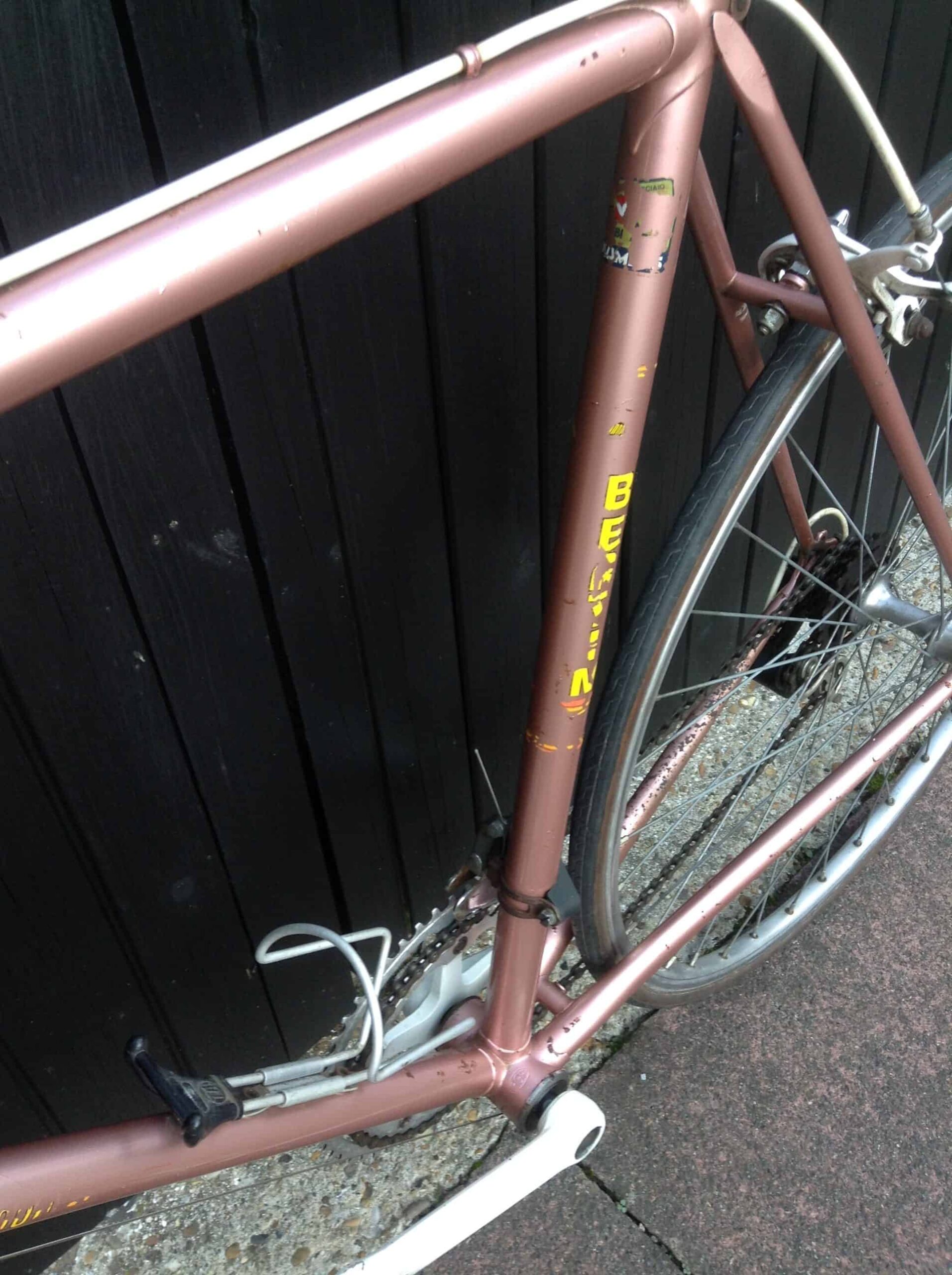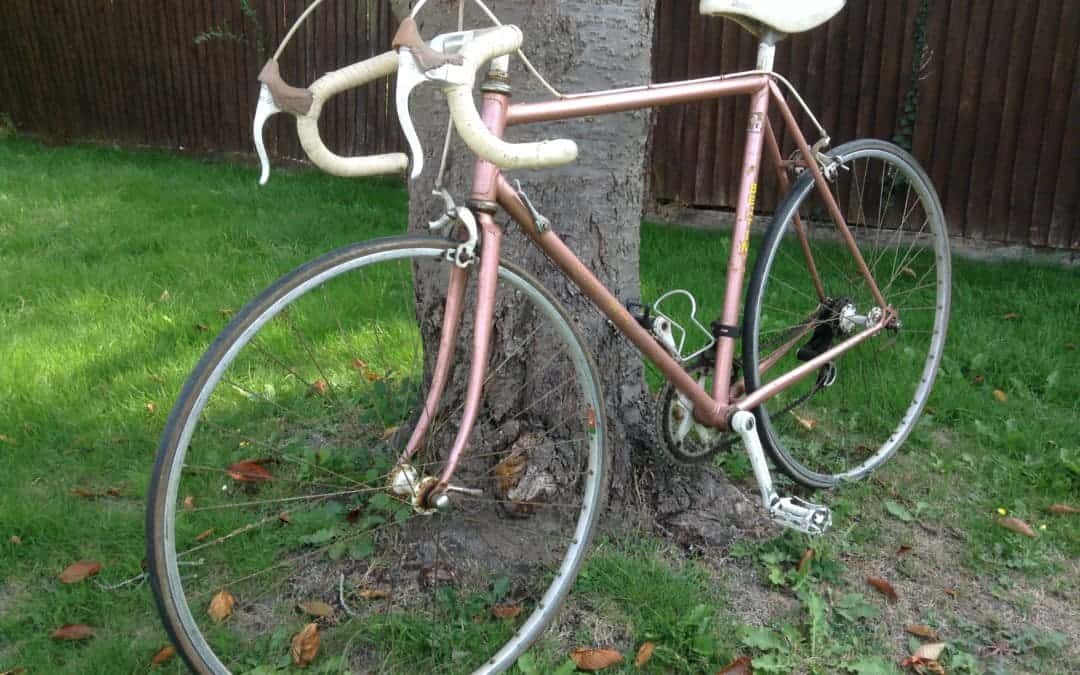Bertin with a White Groupset
This is a bit of a Champagne bike to me. Not only is it the colour of pink Champagne, which is a great shade, but it is rather flashy build with its white groupset. White groupsets must be great when you first buy a bike, but over time the finish of the components always seem to start looking a bit sad. I can certainly say this about the Bertin, which has white hubs, brake levers and calipers, crank, seatpost and pedals. Only the derailleurs and shifters are the exceptions, which are quite unusual mixture Ofmega and Shimano Arabesque. It’s a strange build, and I don’t know what model it is yet..

The Old Lady in the Woods
I had a very hard time finding the address of the old couple who sold me this bike. It wasn’t on Google Maps and neither could my innately stupid Garmin GPS help me find the house. Eventually, I stumbled across the place that was hidden away, deep in the French countryside. I expected the bike to be in better condition, to be honest, but at no time did I act disappointed when the old man wheeled it out to me from his dilapidated cottage. They were a strange couple, and the old lady took offence when I offered her just a little less than she was asking for it. Believe me, it was a fair price. She haggled and complained angrily, until she threw her arms up in defeat, cursing her misfortune and frustration. But wasn’t until I got back to Britain that I started to realise that these bad omens had followed me home.

Columbus Decal
Bad Karma
Luck and fortune does play a part in buying a vintage bike, or a classic car, in my mind. You soon know, once you have a bike on the work stand, whether you are dealing with something pleasing and beneficial, or if it’s a bike that’s just one giant pain in the ass. A musician friend always used the motto “if it can, it will”, about cables getting hooked around chair legs, or guitars and microphones finding a way to fall over. You can start believing, feeling, that things are working against you, especially with mechanics. Every part of this bike seemed resolute in causing me pain and frustration. It felt cursed.

Ofmega Pedals
What Went Wrong
Things got difficult from the get-go. Firstly, the wheels: I have a video of this disaster, but in two words: bent hub. Immediately afterwards, the Stronglight dust cap on the drive side of the crank exploded as I tried to unscrew it. Next, the crank absolutely refused to come off with the crank puller, both arms stubbornly fighting me for an hour. After this hard labour, the front derailleur cable painfully cut my hand as I lifted the bike to the stand. It was my turn to curse my luck. As I looked more closely at this derailleur which cut me good, my heart sank; the plastic bracket attaching it to the seat tube was broken a la Simplex. And that’s not all: one of the Ofmega rear derailleur jockey wheels didn’t spin well, even after a good clean and lubrication. Oh, and the adjustable bottom bracket cup would not thread back in for some mystical reason. It felt like everything, everything, went wrong.

The Ofmega Derailleur
What were you Thinking, Ofmega?
So Ofmega went down the Simplex road, and began to produce derailleurs with plastic inspired by the idea that this was the future. Don’t get me wrong, I like Ofmega components, but I just don’t like plastic in my vintage derailleurs. On the Disraeli gears page for this Mistral, the opinion is the Mistral “is a genuine, high quality, precision, cycling product”, and the plastic isn’t really plastic, it’s h-tech polymer. Oh, ok. Well then, Ofmega, how do you explain this little problem below? It looks just like one of the many broken Simplex derailleurs I have.

Hi-Tech Polymer, Really??
The Bent Rear Hub
I like these white hubs, which are actually made by Gipiemme. They may look dirty and be hard to keep clean, but they are quite distinctive and interesting. Both wheels needed a lot of work, mostly in removing the layers of rust from the spokes. Needless to say, the spokes didn’t come out that well, indeed, you could call them in “close to ditching” condition. The biggest problem was the rear hub, that had kept a nasty surprise for me. I did notice it was a bit loose when I bounced the rear wheel, but I didn’t expect such a major problem. Here is the video below about my next encounter with this cursed restoration.
Touching Up White Components
I don’t normally like using touch up paint, especially on a quality frameset. When it comes to components, there aren’t many that it would be necessary to repaint, but in this case, I felt something had to be done with them. Either I could swap them out or try improving the look of their raggedy finish, especially the crank. It had lots of chips and scars exposing bare metal underneath, and it ruined the whole look of the whole bike. Luckily, I had some white touch up paint to hand, which seemed a decent match for aged white finish. It’s really difficult to get a perfect match, but I felt I had nothing to lose and used a thin brush to fill the worst of the chips and scars.

The Scarred Crank

Ready For Painting

Painted

Left Arm
Did it Work?
Sort of. It looked better just after I painted it, but a day after, when the paint dried, it was easy to see where the new paint had been added and the brush marks. Still, it looks better now, and from a distance it’s a hell of an improvement. I suppose if you’re a perfectionist, it wouldn’t do at all. But if you want to cut down the cost of a restoration, then it is a utilitarian way of improving the look of components that are aesthetically challenged. At least, unlike the recent Campagnolo crankset I came across, one made with a Graphite finish, this Stronglight crankset was actually restorable.

Ofmega Bottom Bracket


Cleaning the Cage
A Custom Build?
A French threaded Ofmega bottom bracket..? Those can’t be common, and I wonder why this bike was built with these Italian parts. Was it a custom build? I’m not sure, as I’m no expert on Bertin models. I just have to add that cleaning ball bearing cages is an absolute pain! Are these small things, with their little metal hooks, the most difficult of all parts on a bike to clean? However, once the bottom bracket was back on, everything, well, got a little easier; it seemed like the bike began cooperating. The chain was in reusable condition, and the white Shimano brakes had spring tension and worked well. It began to look like a rideable bike again.

The Rusty Spokes
Lifting the Curse
With a re-greased bottom bracket and a replacement set of wheels, this Bertin actually rides very well now. I would have liked to keep the white Gipiemme hubs which are original to the bike, but the rear was unusable, and the mismatched pair just wouldn’t look good. Instead, I swapped them out for a wheelset from the same era, with Pelissier hubs and Rigida clincher rims. It’s quite an unusual bike with these distinctive but varied parts, but the good thing is, they work well together. I’m also guessing that this frame was made around 1981, being French threaded but having braze-on mountings. What does RGF mean on the bottom bracket shell? Here’s a link with the explanation.












Specs
- Bertin ( Sold by Cycles 2000 ) 1981?
- 56cm Frame, Centre to Top, 55cm Top Tube, Centre to Centre
- Columbus Tubing
- Gipiemme Dropouts, Braze on Shifter Bosses, Bracket Mounted Front Derailleur
- Long Pointed Bocama Lugs, Sloped Fork Crowns, Eyelets on Dropouts
- Ofmega Bottom Bracket, French Threaded 35 x 1
- Ofmega Headset, 22mm Steerer Diameter
- Ofmega Mistral Rear Derailleur
- Ofmega Mistral Front Derailleur ( Broken )
- Ofmega Platform Pedals
- Stronglight 106 White Crankset
- Shimano White Levers and Calipers ( Z Series? )
- Shimano 600 Arabesque Shifters
- Philippe Professionnel Handlebars
- Unknown White Stem
- White Gipiemme Hubs, Mavic Module C Clincher Rims
- White SR Seatpost, 26.2mm
- Mundialita White Saddle


Hey mate!
i’m starting to restore a bike just like that, planing to convert them to single speed.
any idea what model is it?
Hi, that one looks like it needs a lot of work, but it’s worth it. Really hard to say what model it is, have a look here for some more information:
Thanks for posting. How about a picture of it when it’s restored?
Dominic